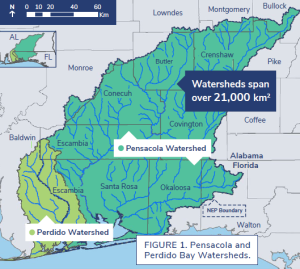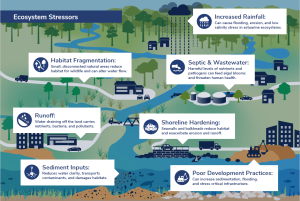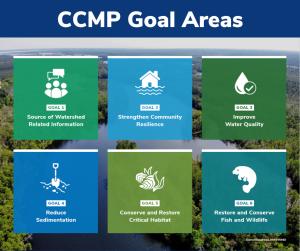
One of the realities of any sort of environmental or quasi-governmental work is learning all the acronyms. EPA , FDEP, FWC, UF IFAS—it’s always an alphabet soup of organizations. Today, I introduce the “PPBEP CCMP,” which stands for the Pensacola & Perdido Bays Estuary Program (PPBEP) Comprehensive Conservation and Management Plan (CCMP). Now you see why we use all these acronyms! The PPBEP is an expansion of a multi-jurisdictional organization known as the Bay Area Resource Council (BARC), which formed in the late 1980’s to work across municipal boundaries and address shared water quality concerns in and around Escambia, Santa Rosa, and Okaloosa County. As a historic city, Pensacola especially has a long legacy of environmental issues from the days before we knew better—and plenty more even after we understood what we were doing.

Many regions around the country have benefited greatly from an EPA initiative called the National Estuary Program (NEP), which creates non-regulatory organizations in coastal areas to facilitate cross-agency and cross-boundary work to solve water quality problems strategically. One of the most impressive success stories in Florida is that of the Tampa Bay National Estuary Program, which—over a span of 30 years—succeeded in restoring 15,000 acres of healthy seagrass beds. By 2018, Tampa Bay (one of the most populated regions in Florida) had more grass coverage than in 1950, before urbanization took off. This was achieved through years of partnerships, goal setting, and a shared effort to meet those goals among members of the residential, agricultural, industrial, business, and governmental sectors. Seeing this process work in other parts of the country, BARC members took advantage of federal funding available after the Deepwater Horizon oil spill. This resulted in a $2 million grant from the Resources and Ecosystems Sustainability, Tourist Opportunities, and Revived Economies of the Gulf Coast States (RESTORE) Act to fund the PPBEP. While currently considered a “local” Estuary Program, the ultimate goal is for the PPBEP to gain designation as a National Estuary Program, securing continued funding and support from the EPA.

As part of the RESTORE grant requirements and deadlines, the PPBEP policy board, staff, committees, and interested parties were tasked with creating an overall plan that outlines community-wide environmental priorities. This is the Comprehensive Conservation and Management Plan (CCMP). The CCMP represents a tremendous amount of thoughtful work, including results from a community survey and multiple stakeholder meetings. The PPBEP includes nearly 80 partners, including private businesses, non-profit organizations, state agencies, Pensacola NAS, universities, cities, and county governments. Trying to wrangle all those voices and perspectives from two states (the Pensacola and Perdido Bay watersheds are 60% and 70%, respectively, in Alabama) into a single, easy-to-read, comprehensive report represents a formidable effort by the PPBEP staff.

The resulting CCMP document is now available in draft form, and staff are requesting comments from the community before its official launch. While it is over 200 pages, the photography and graphic design capture the beauty and history of the region and the narrative is clear, making it accessible to non-scientists. Take a moment to scroll through the document, learn a little about the program and local issues, and take a moment to leave a comment and make sure your voice is heard. The CCMP should fully reflect the needs and perspectives of the broader community. If you or anyone you know lives or spends significant time in the watershed area, please share the link with them. The comment period ends at 11:59 pm on August 28, 2022. The PPBEP has been a collaborative effort from day one, and your feedback is valuable.
 3
3
